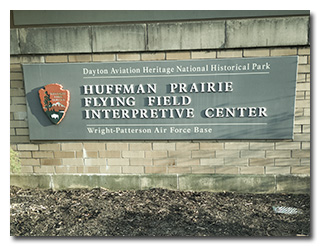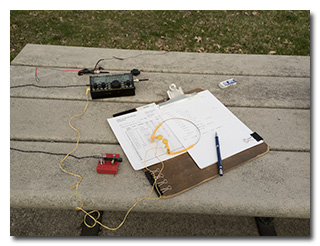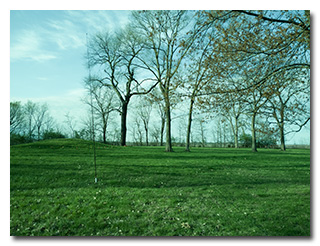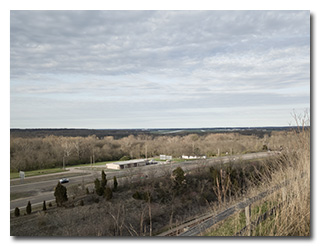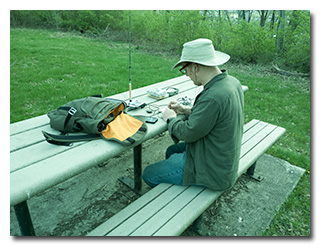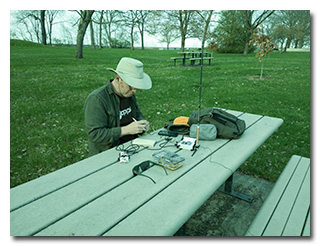
by William Eric McFadden
From the Dayton Aviation Heritage National Historical Park website:
-
Dayton Aviation Heritage National Historical Park was established to honor the lives and achievements of poet and author Paul Laurence Dunbar and aviation pioneers Wilbur and Orville Wright. Through perseverance and dedication Orville, Wilbur and Paul were able to overcome obstacles in their lives and leave their respective marks on history.
Pictures
- The Huffman Prairie Flying Field Interpretive Center sign
- Eric's KX2 station
- Eric's 35' EFRW Antenna and Mast
- Thomas Witherspoon, K4SWL, operating on 40m with his KH1: 1 | 2
- The view down onto Wright-Patterson Air Force Base
Description
On Sunday, April 7, 2024, two members of the Southeast Ohio Radio Adventure Team performed successful activations of Dayton Aviation Heritage National Historical Park (US-0732) as part of the Parks on the Air (POTA; link) program.
Both the McFadden family and the Witherspoon family traveled from their homes in southeastern Ohio and western North Carolina, respectively, to Dayton to experience the total solar eclipse which was to occur on the afternoon of Monday, April 8. Eric McFadden, WD8RIF, and Thomas Witherspoon, K4SWL, had hoped to perform activations of two new-to-them POTA units about an hour's drive west of Dayton on Sunday evening, but the timing didn't work out. Instead, they visited the Dayton Aviation Heritage National Historical Park at the Huffman Prairie Flying Field Interpretive Center for a pair of quick activations.
Eric and Thomas (plus Eric's little dog, Theo) arrived at the Huffman Prairie Flying Field Interpretive Center at about 2200 UTC to find the gate open but the Interpretive Center itself to be "closed for the winter". Other visitors were enjoying the grounds, though, so Eric and Thomas felt comfortable performing their activations.
Eric and Thomas each chose a picnic table, ensuring some small amount of distance lay between the tables to help reduce mutual interference between their stations. Thomas chose to operate on 40m with his Elecraft KH1 transceiver, the KH1's standard whip antenna, the AX1 antenna system's AXE1 40m extension coil, and the KHRA1 right-angle whip mount which allowed him to place the KH1 flat on the picnic table. Eric chose to operate on 20m with his Elecraft KX2 and a Tufteln (link) 35' end-fed random wire antenna sloping up to the top of a Goture Red Fox Super Hard 720 carbon-fiber mast held upright on a spike. Eric was on the air at 2219 UTC. Thomas was on the air a few minutes later due to his need to record an intro for his activation video before he could start operating.
WD8RIF
As expected, Eric had excellent cell-signal and he would be able to spot himself on the POTA Spots website (link) and to use POTA Spots to identify possible Park-to-Park (P2P) QSOs.
Eric began his operation on 20m by finding himself a clear frequency to run, spotting himself on POTA Spots, and calling "CQ POTA". His first QSO came at 2220 UTC with NS1C in Florida. QSOs came quickly, with his twelfth QSO coming at 2234 UTC with WA5EEZ in Oklahoma. This run included QSOs with operators located in Florida (3), Colorado, Texas (3), Utah, North Dakota, Minnesota, Alabama, and Oklahoma.
Eric finished his activation by changing to 40m, turning his KX2 down to 100mW of output, and completing a P2P QSO at 2236 UTC with Thomas who was, of course, just a few yards away in the same park.
All of Eric's QSOs were CW and were made at 5W (or 100mW for his final QSO) output.
Eric also submitted his log to the World Wide Flora and Fauna in Amateur Radio (WWFF; link) program for an operation at Dayton Aviation Heritage National Historical Park, KFF-0732.
K4SWL
Thomas's web-report and associated video will be available soon.
(return)
